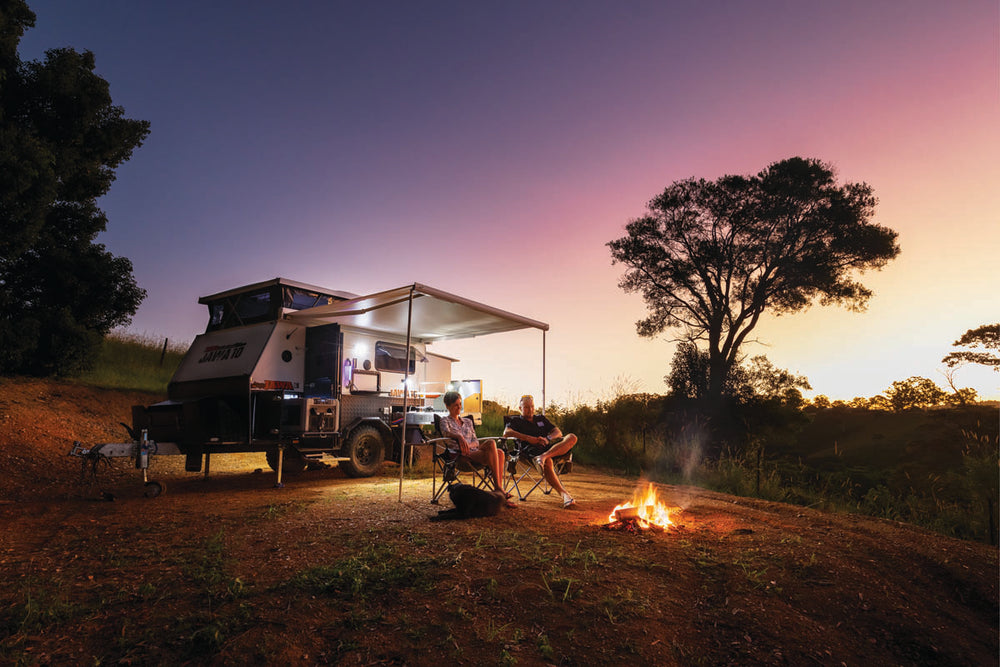DIY Budget Van Modifications
Vans these days come with a raft of inclusions but, as you spend more time on the road and at camp, you will always come across things that will make your setup just that little bit better. Here are some simple DIY projects that can make the world of difference to your rig.
PVC ANNEXE POLE CARRIER
Sick of having your annexe poles rattling about the place? Here’s an easy fix. Obtain a suitable length (usually just short of the width of your RV) of round, 150mm diameter PVC tube and two push-on end caps from your plumbing supplier. You will also need supporting brackets and two 180mm long by 8-10mm diameter bolts or T-pins with clevis.
Because the end caps are effectively ‘push-on’, not screw-on, they require an attachment such as a pin or long bolt to keep them in place. If T-pins are used instead of a bolt, most of these come with a clevis pin, and with the clevis pin removed, a small padlock can be used for additional security.
Place the end caps on the pipe and use a straight edge to mark the centreline of the cap and its short return. The holes need to be diagonally opposed to take the long bolt or T-pin.
Using a 3mm bit, drill both sides, penetrating the cap and the pipe, and check the centreline again with your square. If okay, commence drilling the hole just oversize to that of your bolt or pin. Slip the bolt or pin through to secure the end cap to the pipe.
Most pole carriers are mounted on the front or rear underside of a van, so take a few moments to determine the best position for you before attaching the pole carrier with the support brackets to the RV.
Alternatively, ready-made pole carriers with screw-on cap ends and ready-to-install hardware are also available from most RV parts centres.
ROPE TRACK FOR A SHADE SCREEN
When you pull into camp, it’s nice to have a bit of shade and installing a rope track for a shade screen is a pretty easy DIY project. First, obtain the desired length of rope track and colour-coded screws from your RV parts centre. The awning shade can be purchased in multiple sizes to suit the rope track length.
Before you begin, ensure the RV is not connected to 240V mains power. If installing on a pop-top, lay the track on the roof (closed position) and align along the corner edge. Mark the location, remove the track, then clean the surface and lay a length of waterproof sealant to the area. Place the track back on the roof and, starting at one end, use a battery drill to fasten the track. We suggest the same installation for caravans with aluminium cladding.
For RVs with solid or double-sided walls, mount the track on the side wall and, pending the location of windows, vents, etc., try to position the track about 200mm below the roofline. Use masking tape to hold the track in place while you level off. Mark the track then remove it, clean the area and apply waterproof sealant. Place a screw at one end then recheck your level before moving along the track, fastening it to the wall.
After you’re done, reconnect the mains power and check that powerpoints are operative along this wall, as well as the 12V lighting.
FRESH WATER FILTER
This task will depend on the plumbing under your sink – in this instance, it was a plastic hose connected to a flick mixer pressure tap.
Fresh water filters are vast and varied from single to twin elements, so do your homework before taking the plunge. Your decision may also be impacted by the space you have under your sink and, if this is insufficient you may select a cupboard close by.
Most RV parts centres stock the filters, plastic water pipe, junctions, taps and fittings required to DIY. The following are useful tricks for installing filters:
- Mount the filters on a solid wall.
- Ensure you have space to change the filters periodically.
- You can discard your two-way flick mixer for a three-way or you may need to drill a hole in the sink to mount a remote spout. Before commencing, check that you have the space under the sink to gain access to the spouts mounting flange.
- After cutting and reconnecting the cold water hoses, check for leaks via mains water pressure.







